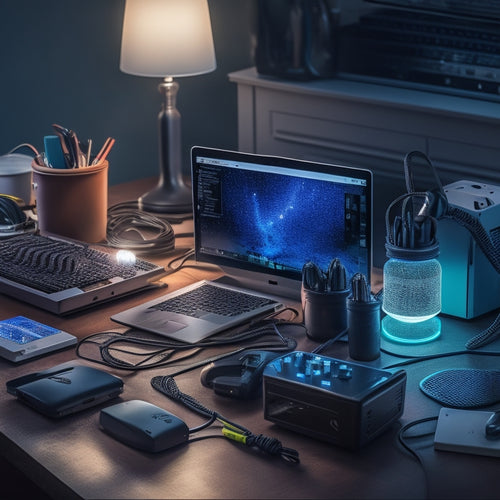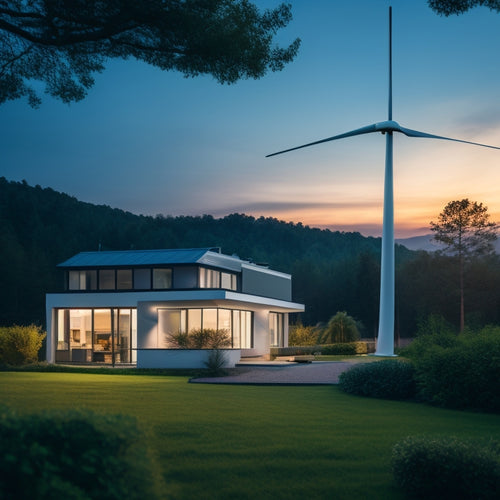
7 Best Air-Purifying Innovations for Eco-Friendly Home Living
Share
You're about to uncover the latest breakthroughs in air purification, perfect for creating an eco-friendly haven in your home. From advanced HEPA filtration systems that capture 99.97% of particles as small as 0.3 microns, to smart air quality sensors that monitor pollutants in real-time, the options are endless. Whole house ventilation systems guarantee a constant flow of fresh air, while photocatalytic oxidation technology breaks down pollutants using light. Activated carbon air purifiers, UV light purification systems, and ionization air cleaning devices offer additional ways to breathe easy. Now, delve into these state-of-the-art innovations and take the first step towards a healthier, more sustainable living space - and reveal even more innovative solutions waiting to be examined.
Key Takeaways
- Advanced HEPA filtration systems capture 99.97% of particles as small as 0.3 microns, improving indoor air quality and health.
- Photocatalytic oxidation technology utilizes light to break down pollutants like VOCs and nitrogen oxides, offering a sustainable air purification solution.
- Smart air quality sensors continuously monitor indoor air for pollutants and toxins, providing real-time alerts for immediate action.
- Whole house ventilation systems create paths for fresh air inflow while expelling stale air, maintaining good indoor air quality and reducing energy costs.
- Ionization air cleaning devices use negative ions to attract and trap airborne pollutants, providing a quieter and more energy-efficient purification method.
Advanced HEPA Filtration Systems
With the growing awareness of indoor air pollution, advanced HEPA filtration systems have emerged as a guiding light of hope for homeowners seeking to breathe easier.
As the world shifts towards sustainable resource utilization, it's crucial to reflect on the environmental benefits of electric vehicles reducing greenhouse gas emissions that can contribute to indoor air pollution.
You can now enjoy the benefits of clean air without sacrificing your freedom to move around. Portable air purifiers equipped with advanced filtration technologies allow you to take clean air with you wherever you go.
These systems capture 99.97% of particles as small as 0.3 microns, including dust, pollen, and other airborne allergens.
By incorporating advanced HEPA filtration systems into your home, you'll be able to breathe easier, sleep better, and live healthier.
Say goodbye to respiratory issues and hello to a life of freedom and well-being.
Smart Air Quality Sensors
You're now one step closer to creating a healthier indoor environment with smart air quality sensors.
These innovative devices continuously monitor the air you breathe, providing you with accurate readings on pollutants and toxins.
With real-time pollution alerts, you'll be enabled to take immediate action to purify the air and safeguard your well-being.
Air Quality Monitoring
Monitoring air quality is vital in today's pollution-prone environment, as it directly impacts our health and well-being. You can take charge of the air you breathe by using smart air quality sensors that provide real-time data on pollutants and toxins, which is especially significant in areas with high carbon footprint solar-powered charging.
Additionally, reducing our reliance on traditional power sources can also contribute to a healthier environment. These sensors can be integrated with air quality apps, giving you an extensive overview of your indoor air quality.
You can then take steps to improve it, such as introducing indoor plants that are known to purify the air or adjusting your ventilation system. By staying informed, you can create a healthier living space that promotes your overall well-being.
Real-time Pollution Alerts
One of the most critical features of smart air quality sensors is their ability to provide real-time pollution alerts, enabling you to take immediate action when pollutant levels spike. This feature is essential for maintaining indoor air safety and promoting pollution awareness.
With real-time alerts, you can reduce your carbon footprint by adopting eco-friendly fleet solutions that reduce greenhouse gas emissions by up to 75% renewable energy integration. Additionally, streamlining logistics and optimizing routes can minimize fuel consumption and lower emissions.
-
Take immediate action: Receive notifications when pollutant levels exceed safe limits, allowing you to turn on air purifiers, open windows, or take other necessary steps.
-
Track pollutant levels: Monitor the concentration of pollutants like PM2.5, CO2, and VOCs in real-time, giving you a clear understanding of your indoor air quality.
-
Make data-driven decisions: Use historical data to identify patterns and trends in indoor air pollution, helping you make informed decisions about your home's ventilation and air purification systems.
Whole House Ventilation Systems
You're likely aware that whole house ventilation systems are essential for maintaining good indoor air quality.
These systems work by creating fresh air inflow paths, which allow stale air to escape while bringing in clean air from outside.
Incorporating energy-efficient designs, such as those found in solar-powered charging stations, can further minimize energy waste.
By doing so, you can reduce your carbon footprint and contribute to a cleaner environment.
Fresh Air Inflow Paths
Throughout your home, fresh air inflow paths are essential for maintaining a healthy indoor environment, and whole house ventilation systems provide an efficient way to do just that.
By incorporating natural ventilation strategies, you can reduce your reliance on mechanical systems and create a more eco-friendly home. In addition, integrating renewable energy solutions, such as solar energy implementation, can further enhance your home's sustainability.
By utilizing solar power, you can reduce your energy costs and carbon footprint. Here's how whole house ventilation systems can help:
- Maximize natural ventilation: Open windows and doors to let fresh air in, especially during cooler parts of the day.
- Utilize indoor plants: Some plants, like peace lilies and spider plants, are natural air purifiers and can help remove pollutants from the air.
- Install trickle vents: These small vents allow a constant flow of fresh air into your home, even when windows and doors are closed.
Automated Ventilation Controls
With whole house ventilation systems, automated ventilation controls take center stage in enhancing your home's air quality and energy efficiency. By automating ventilation, you can guarantee a consistent flow of fresh air while minimizing energy loss. This is especially important in regions with high humidity, where excess moisture can lead to mold growth and poor indoor air quality. Automated controls also enable noise reduction, allowing you to enjoy a peaceful living space.
| Feature | Benefit | Description |
|---|---|---|
| Humidity Control | Reduces mold growth | Automatically adjusts ventilation to maintain ideal humidity levels |
| Noise Reduction | Enhances comfort | Minimizes fan noise for a quieter living space |
| Energy Efficiency | Saves energy | Enhances ventilation to reduce energy loss and consumption |
| Customization | Flexibility | Allows you to tailor ventilation to your specific needs and preferences |
Energy Recovery Options
Utilizing the power of energy recovery options in whole house ventilation systems can considerably reduce the energy required to heat or cool your home, while maintaining a consistent flow of fresh air.
This innovative approach allows you to enjoy a healthier indoor environment while minimizing your carbon footprint.
Consider the following benefits of energy recovery options:
-
Energy Efficiency: Energy recovery ventilators (ERVs) and heat recovery systems can recover up to 80% of the energy that would otherwise be lost, reducing your energy bills and environmental impact.
-
Improved Indoor Air Quality: By recovering heat and moisture from exhaust air, ERVs and heat recovery systems can provide a consistent flow of fresh air while minimizing the need for heating and cooling.
-
Cost-Effective: Energy recovery options can be more cost-effective than traditional ventilation systems, especially in regions with extreme temperatures.
Photocatalytic Oxidation Technology
Cities are notorious for their poor air quality, and it's no secret that pollutants like volatile organic compounds (VOCs) and nitrogen oxides are major contributors to this problem.
You can breathe easier with photocatalytic oxidation technology, which utilizes the power of light to break down pollutants. This innovative technology uses titanium dioxide, a semiconductor material, to create a reaction that destroys VOCs and nitrogen oxides.
The result is improved indoor air quality and a healthier living space. With high photocatalytic efficiency, this technology can remove up to 99% of pollutants from the air, giving you peace of mind and a cleaner environment.
Activated Carbon Air Purifiers
You've got another powerful ally in the fight for clean air: activated carbon air purifiers.
These devices utilize the power of activated carbon to remove pollutants and toxins from the air, leaving your home environment fresh and clean.
Here are three key benefits of activated carbon air purifiers:
-
Odor removal: Activated carbon is highly effective at eliminating unpleasant smells and odors from the air, creating a more comfortable living space.
-
Chemical removal: Activated carbon can absorb and remove harmful chemicals, such as VOCs and gases, that can aggravate respiratory issues.
-
Long-lasting performance: Activated carbon air purifiers can last for months or even years with proper maintenance, making them a cost-effective solution for clean air.
UV Light Purification Systems
Step into the world of UV light purification systems, which take air purification to the next level by utilizing the power of ultraviolet light.
You'll benefit from UV sterilization benefits, which eliminate germs, bacteria, and viruses that can cause illness. These systems use UV light to destroy microorganisms, providing a chemical-free and eco-friendly way to purify the air.
When choosing a UV light purification system, make sure you opt for one that prioritizes UV light safety. Look for systems with protective casing and automatic shut-off features to prevent accidental exposure.
With UV light purification systems, you can breathe easy knowing your air is clean and fresh, giving you the freedom to live life to the fullest.
Ionization Air Cleaning Devices
Several ionization air cleaning devices have emerged as a popular alternative to traditional air purification systems. These devices use negative ions to attract and trap airborne pollutants, providing you with cleaner air to breathe.
While they offer several benefits, it's crucial to examine the concerns surrounding ozone emissions.
Here are three key points to reflect on:
-
Ionization benefits: Ionization air cleaning devices are often quieter and more energy-efficient than traditional systems. They can also help reduce allergy and asthma symptoms by removing airborne irritants.
-
Ozone concerns: Some ionization devices can produce ozone, a known lung irritant. Look for devices that emit minimal ozone or have an ozone-reducing feature.
-
Effectiveness: Ionization devices can be less effective in larger spaces or against certain types of pollutants. Be sure to choose a device suitable for your space and specific air quality needs.
Frequently Asked Questions
Can Air Purifiers Also Remove Pollutants From Carpets and Upholstery?
You wonder if air purifiers can tackle the hidden villains lurking in your carpet and upholstery. The answer is, some can! Look for purifiers with advanced filtration systems that capture carpet pollutants, making upholstery cleaning a whole lot easier.
How Often Should I Replace Air Purifier Filters for Optimal Performance?
You'll want to prioritize filter maintenance to guarantee your air purifier runs efficiently; typically, you should replace filters every 3-6 months, but check your device's replacement schedule to maximize performance and breathe easier.
Are Air Purifiers Effective Against Mold and Mildew Growth?
You might think mold and mildew are unstoppable, but air purifiers can actually help. By capturing mold spores, they prevent them from spreading, and by controlling indoor humidity, they create an environment where mold and mildew can't thrive.
Can I Use Air Purifiers in Conjunction With HVAC Systems?
You can integrate air purifiers with your HVAC system to enhance air quality and energy efficiency. By doing so, you'll create a more thorough air cleaning solution, enjoying fresher air while reducing energy consumption and costs.
Do Air Purifiers Also Eliminate Unpleasant Odors and Smells?
You're wondering if air purifiers can tackle unpleasant odors and smells. Yes, many air purifiers feature odor removal capabilities, and some even offer scent enhancement options, ensuring you breathe fresh, clean air that's free from unwanted smells.
Related Posts
-

What Do Power Strips Do for Standby Energy?
You're likely aware that your devices, such as TVs and computers, continue to draw power even when turned off, a phen...
-

5 Ways Geothermal Power Boosts Electric Vehicle Efficiency
You're likely unaware that geothermal power can greatly enhance your electric vehicle's (EV's) performance, range, an...
-

10 Grid-Tied Wind Power Systems for Modern Homes
You're looking for a grid-tied wind power system to utilize wind energy for your modern home. Here are ten options to...


